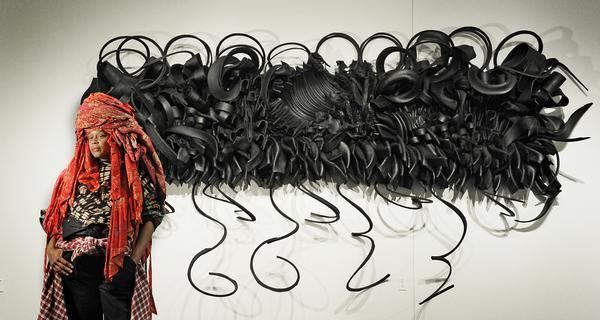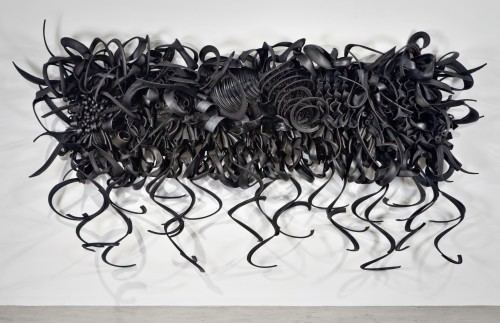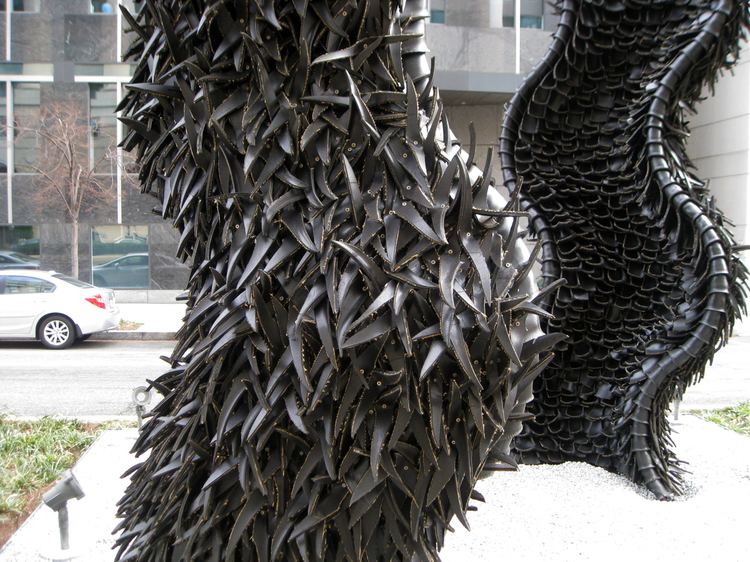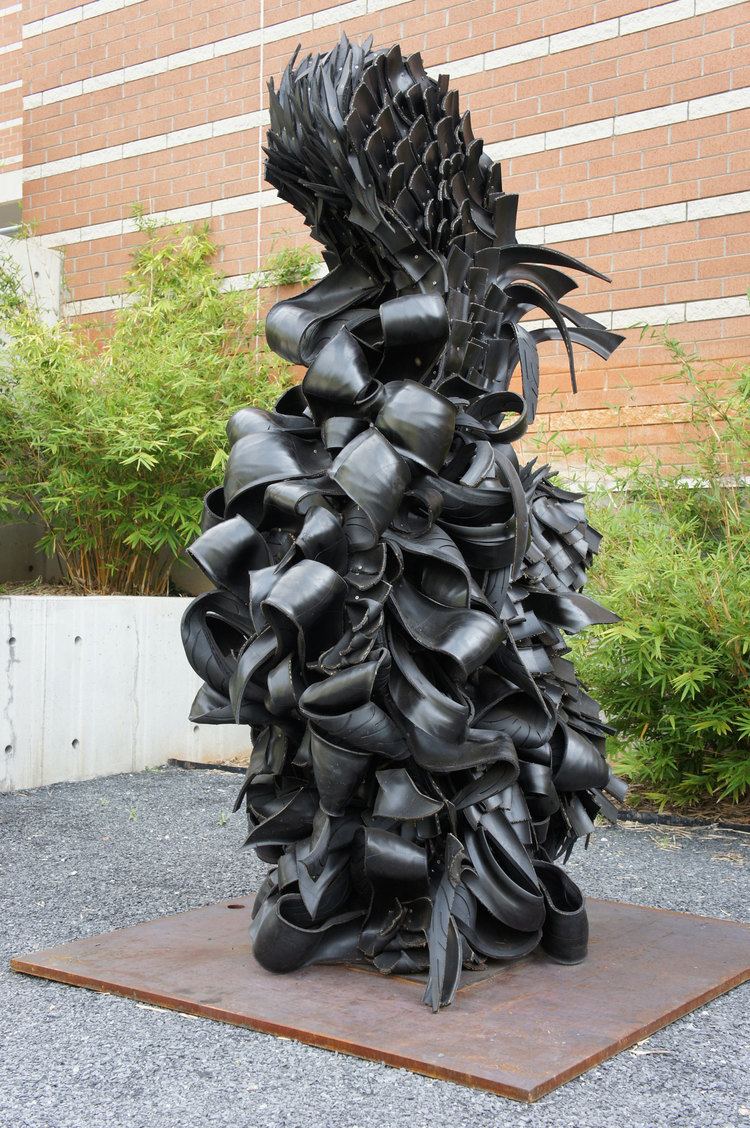Name Chakaia Booker | Role Artist | |
 | ||
Similar People Renee Stout, Sonya Clark, Leo Villareal | ||
Chakaia booker mass transit
Chakaia Booker (born in 1953 Newark, New Jersey) is an American artist.
Contents
- Chakaia booker mass transit
- Tedxnasa chakaia booker 11 20 09
- Background
- Career
- Works and exhibits
- References

Tedxnasa chakaia booker 11 20 09
Background

Booker received a Bachelor of Arts in Sociology from Rutgers University in 1976. She then received her Master of Fine Arts from the City College of New York (CUNY) in 1993. Now in her sixties, Booker has studied a variety of different subjects including African dance, ceramics, weaving, basketry as well as t'ai chi which all contribute to her interesting artistic practices. Booker always felt the need to utilize these skills differently as a means of experimentation and play. These skills were all translated into a tool for creating her elaborate sculptures.
Career

Like her sculptures, Booker is a carefully assembled and richly layered individual who sees herself as a sculpture through her tasks of dressing, sewing, cooking, and other daily activities which she considers to be art forms in their own rights.

Beginning in the 1980s Booker created wearable sculptures which she could place herself inside and utilize as clothing. "The wearable garment sculpture was about getting energy and feeling from a desired design." Booker continues to create a wearable sculpture in response to the materials which she uses in her current work. From her creations of wearable sculptures in the 1980s, Booker began to create work from discarded materials which she found at construction sites. These found materials each had its own purpose, history, and use which she finds interesting. This search for discarded materials brings us to the "rubber tire" from which her most notorious work is created.
Booker began working with rubber tires in the early 1990s and presently continues to work in this medium. The various tread patterns, colors, and widths which the tires possess create a palette for Booker similar to the palette of painter. Booker's utiliztation of tires was considered to be an "aesthetic response to the urban landscape of Northern New Jersey." The rubber and tires were transformed into fluid materials giving them a new life and energy. The tires represented metaphors which satisfied aesthetic, political, and economic concerns. Lucinda Masson notes that Booker's use of recycled tires can remind us of how modes of transportation have changed since the industrial age.
Booker's work has layers and layers of meaning loaded with social concerns throughout. The sculptures which were created with the tires are said to address African American identity. The black tires symbolize the strength of African American identity while the color nuances are meant to evoke the complexities of the black humans application. "The varying pigments ranging from blue-black, deep grey and brown, sometimes stamped with blue or red as well as textures- matte, smooth, glossy, cracked, game encrusted represent the range of African American skin tones." "Salvaging such defiant beauty from scraps of resilient black, rubber [provides] a compelling metaphor of African American survival in the modern world."
Her current work presents a level of acknowledgment to her African heritage and its influential artwork. The tread pattern of the tires in her work represent the scarification and body painting which was once and still is present in particular African cultures. As in a piece from 1994 a mask which was "untitled" "similar to Picasso, Booker appears to draw from distorted facial features of West African Tribal marks is a less quotation of formal images and a greater assertion of African American identity and aesthetic lineage." Tread patterns and repetitive geometric shapes throughout Booker's work are reminiscent of traditional African textiles. "Overall the tires characterize, symbolize, and or signify a toughness, linked to the will of the African diaspora for continued survival .
Although the representation of African American identity seems very prominent throughout Booker's work it is by no means her sole concern. "Booker's work calls attention to slavery, industrial revolution, working class, factory labor and even addresses the qualities of rubber." Booker's "Echoes in Black" from the 2000 Whitney Biennial deals with scarification both emotional and physical that people go through in life through class, race, and labor. As for her piece "No More Milk and Cookies" from 2003, this work "questions our commercially driven society and what happens when consumption is prohibited." Her 2001 piece "Wench (Wrench) III" is a surrealistic sculpture which subverts a very masculine mechanic's wrench into a feminine feather boa. The piece "Spirit Hunter" is reminiscent of images of life and death as well as a feminist approach to birth and sexuality. Booker's concerns throughout her work are culturally diverse in regards to mankind and her explorations into the endeavors of the human race allow for her a better understanding of situations than perhaps an ordinary person might endure.
Works and exhibits
Chakaia Booker currently works and resides in New York City. Her artistic career has enabled her to be a part of the permanent collection at the Metropolitan Museum of Art, the Akron Museum of Art, Cornell University's Johnson Museum of Art, The Max Protetch and June Kelly galleries in New York and others as well. She has participated in both group and solo exhibitions in such places as the Neuberger Museum of Art, the Akron Museum of Art, Marlborough gallery, the Sandler Hudson Gallery in Atlanta, Georgia, and the P.S.I. Contemporary Art Center in Queens, as well as in the "Twentieth Century American Sculpture" exhibition held at the White House in 1996. On June 22, 2008, Booker unveiled "Chaikaia Booker: Mass Transit", in Indianapolis, Indiana. This public art exhibition featured 10 sculptures "created by the artist following her visit to Indianapolis and her researching of the city's history and heritage."
The National Museum of Women in the Arts has exhibited her works in The New York Avenue Sculpture Project (2012), FOREFRONT: Chakaia Booker (2006) and Reaching for the Stars through Art (1998). The Georgia Museum of Art in Athens, GA also exhibited her work in an exhibition entitled Defiant Beauty, which was on display from April 2012 - 2013. Several of her works were also on display in New York City's Garment District, June–November 2014. Booker's is one of nine contemporary artists with work on display at the Renwick Gallery's Wonder Gallery in the Smithsonian American Art Museum in Washington D.C. The sculpture on display was "It's So Hard to be Green," which was also exhibited at the 2000 Whitney Museum Biennial.
Max Protetch, June Kelly Gallery, Sandler Hudson Gallery in Atlanta, Georgia, and Marlborough Galleries (International) are all prominent Fine Art Galleries, not institutions that hold Chakaia Booker artwork permanently.
